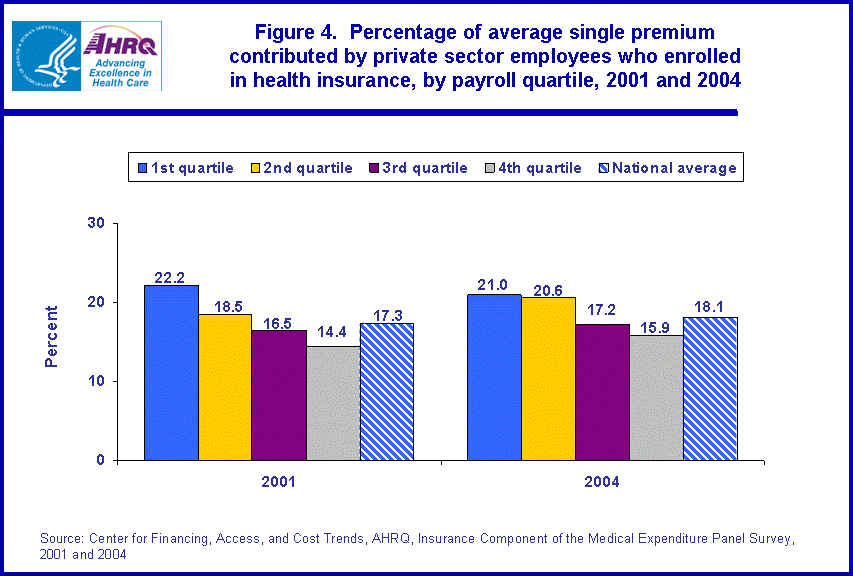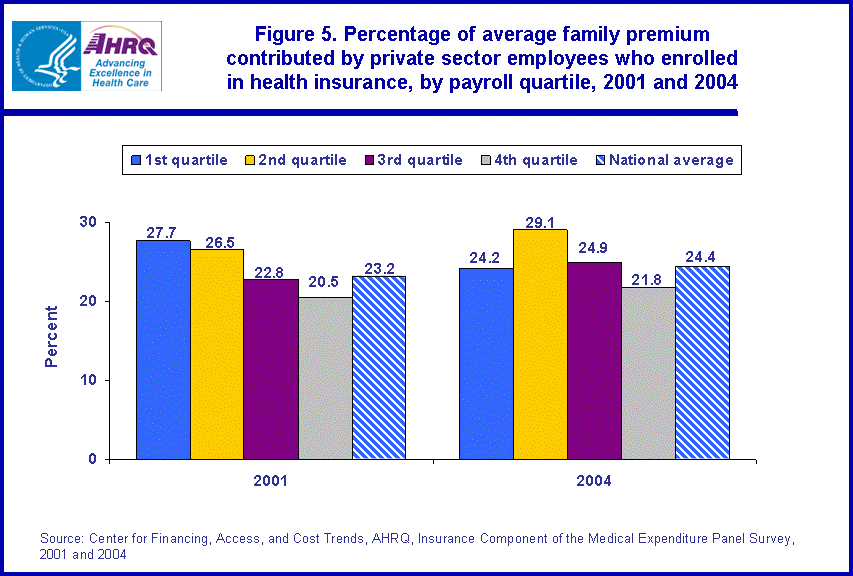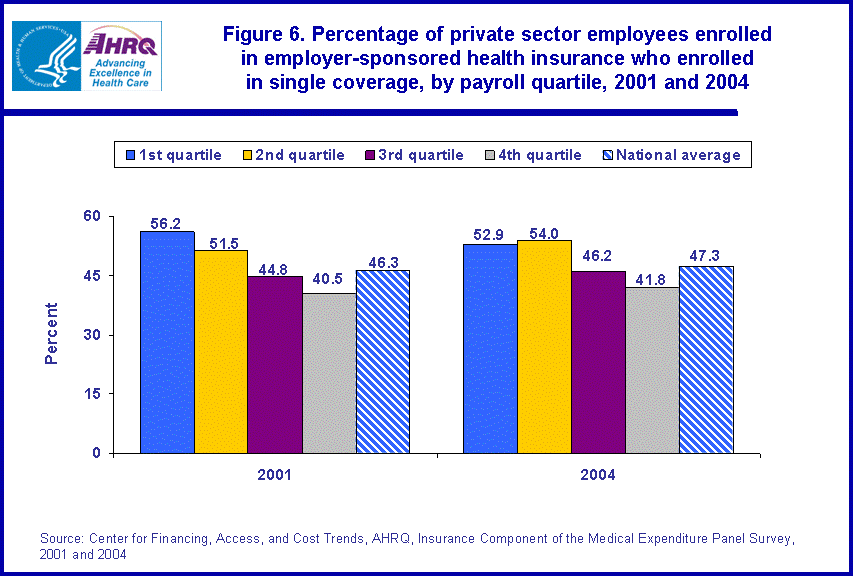
|
|
Font Size:
|
||||
|
|
|
|
||||
STATISTICAL BRIEF #160:
A Comparison of Employer-Sponsored Health Insurance Characteristics for the Private Sector for the Years 2001 and 2004, by Average Payroll
Highlights
- The percentage of private sector establishments that offered health insurance fell 3.2 percentage points, from 58.3 to 55.1 percent between 2001 and 2004. Although rates differed by payroll quartile, the rates for all quartiles fell from 2001 to 2004.
- The percentage of employees in the private sector who worked where health insurance was offered fell from 88.8 to 86.7 percent between 2001 and 2004. Although rates differed by payroll quartile, the rates for all quartiles fell from 2001 to 2004.
- The percentage of private sector employees who worked where health insurance was offered who enrolled changed little between 2001 and 2004.
- The percentage of premiums paid by private sector employees for both single and family coverage rose between 2001 and 2004; however, these percentages did not increase for employees across all payroll quartiles.
- The percentage of private sector employees enrolled in employer health insurance who chose single coverage rose between 2001 and 2004.
Introduction
One of the primary sources of health insurance coverage in the United States is through employers for their current employees. According to data from the Insurance Component of the 2004 Medical Expenditure Panel Survey (MEPS-IC), approximately 60.9 million of the 112.1 million employees in the private sector are enrolled in a health insurance plan sponsored by their employer.
Between 2001 and 2004, the cost of employer-sponsored health insurance for the private sector increased much faster than inflation. For instance, the average single premium in the private sector for employer-sponsored health insurance increased 28.2 percent over that period compared with a 6.7 percent increase in the Consumer Price Index. During that time, offer and enrollment rates have dropped among private sector employers and employees.
Many factors are associated with whether an employee has access to a health insurance plan sponsored by his or her employer, whether the employee enrolls, and the amount the employee contributes towards the cost of coverage. Among employer characteristics associated with employer-sponsored health insurance are the size of the employer, the industry, whether there is a union present, and employee compensation levels.
This Statistical Brief focuses on changes between 2001 and 2004 in the offer, eligibility, and enrollment rates, and the level of employee contributions for private sector establishments (business location), grouped by the average payroll per employee. Each group or quartile contains 25 percent of the total number of employees in the private sector, and each group represents establishments with progressively higher average payrolls. Thus, the first group contains 25 percent of employment in the establishments with the lowest average payrolls per employee while the fourth group contains the highest 25 percent. Only those differences between quartiles or across years that are statistically significant at the 0.05 significance level are discussed. Additional details on the grouping methodology are contained in the Definitions section of this report.
Findings
The percentage of establishments in the private sector that offered health insurance was 55.1 percent in 2004, a drop from 58.3 percent in 2001 (figure 1). This decline was experienced by all payroll quartiles; for instance, the offer rate for the lowest payroll quartile fell from 40.5 to 37.5 percent between the two years while the rate for the highest quartile fell from 84.3 to 79.5 percent during the same period. Although the drop happened across all quartiles, within both years the percentage of establishments that offered health insurance rose as payroll increased. For instance, in 2004, 37.5 percent of establishments in the first payroll quartile offered health insurance while 79.5 percent offered health insurance in the highest payroll quartile.
The percentage of private sector employees who worked where health insurance was offered fell from 88.8 percent in 2001 to 86.7 percent in 2004 (figure 2). This drop happened in all the payroll quartiles; for instance, the rate for the second quartile fell from 89.4 to 86.4 percent over the time period. Within the two years, the rate patterns remained the same. In both years the rates increased as the quartile increased. For instance, the rate in 2004 for the lowest payroll quartile was 70.2 percent while the rate for the highest quartile was 96.5 percent.
The percentage of private sector employees who worked where health insurance was offered who enrolled was 62.6 percent in 2004 (figure 3). The comparable rate in 2001 was 62.2 percent. Although the overall rate changed little, the rate for the second payroll quartile dropped significantly over the period, from 57.6 percent in 2001 to 54.9 percent in 2004. Within both years the enrollment rates become higher as the payroll quartile increased.
The percentage employees contributed towards the premium, for those private sector employees enrolled in single coverage, rose from 17.3 to 18.1 percent during the period from 2001 to the year 2004 (figure 4). Employees in the second payroll quartile had a significant increase from 18.5 to 20.6 percent, as did employees in the fourth payroll quartile, who had an increase in single contribution rate from 14.4 to 15.9 percent during the period. In both years, the pattern held that the single contribution rate decreased as the payroll quartile increased. Thus, in 2004, employees with single coverage in the first payroll quartile paid 21.0 percent of the single premium while employees who worked in the highest paying establishments contributed only 15.9 percent towards their single premiums.
Employees enrolled in family coverage in the private sector also had the portion of premium they contributed increase between 2001 and 2004. In 2001, the portion of family premium contributed by the employee was 23.2 percent while in 2004 the employee contribution towards the same type of coverage was 24.4 percent of the premium (figure 5).
The portion of private sector employees enrolled in employer-sponsored health insurance that enrolled in single coverage increased between 2001 and 2004. In 2001, the portion was 46.3 percent and in 2004 it was 47.3 percent (figure 6). All quartiles of establishments did not show an increase. For instance, the first quartile portion decreased from 56.2 to 52.9 percent. On the other hand, the second quartile showed a large increase from 51.5 to 54.0 percent.
Data Source
This Statistical Brief summarizes data from the 2001 and 2004 MEPS-IC. The data are available on the MEPS Web site at http://www.meps.ahrq.gov/mepsweb/survey_comp/Insurance.jsp or have been produced using special computation runs on the confidential MEPS-IC data available at the U.S. Census Bureau.
Definitions
Establishment
In this Statistical Brief, an establishment is defined as a single business location. Multiple establishments can be controlled by a single entity denoted as a firm. Establishments from the same firm can be in different payroll quartiles defined in the Introduction. This analysis includes only establishments from the private sector.
Quartiles
Quartiles are groups of establishments, each of which contains 25 percent of the total employment. To determine the establishments within each of these employment quarters or quartiles, the following process was used:
- The list of establishments was placed in order from lowest to highest average payroll per employee.
- Starting with the establishment with the lowest average payroll, the employment was summed until the cumulative employment of the establishments on the list was 25 percent of the total employment of all establishments. The set of establishments on the list to that point are in the first quartile.
- The second quartile begins with the next establishment on the list and includes all establishments from that point on the list until the cumulative employment reached 50 percent.
- The third quartile includes all establishments after the second quartile and ends with the establishment that brings the cumulative employment to 75 percent of the total.
- The fourth quartile includes all establishments above the third quartile.
Payroll
Payroll includes all forms of compensation, such as salaries, wages, commissions, dismissal pay, bonuses, and employee contributions to pension plans, but excludes fringe benefits. This definition is the same as that used by the Internal Revenue Service on Form 941.
Percentage of premiums
Percentage of premiums is defined as the ratio of the total of all contributions for all establishments within the payroll quartile divided by the total of all premiums for all establishments within the payroll quartile for the specific type of coverage for the given year.
About MEPS-IC
MEPS-IC is a survey of business establishments and governments that collects information on employer-sponsored health insurance, such as whether insurance is offered, enrollments, types of plans, and premiums. The survey is conducted annually by the U.S. Census Bureau under the sponsorship of the Agency for Healthcare Research and Quality. The yearly response rate has averaged 78 percent for in-scope sample units. Approximately 4 percent of the original sample has been out-of-scope in a typical year. A total sample of 42,000 private sector establishments was selected for the 2004 survey, prior to accounting for losses due to nonresponse and out-of-scope cases.
For more information on this survey, see MEPS Methodology Reports 6, 8, 10, and 14 on the MEPS Web site at http://www.meps.ahrq.gov/mepsweb/data_stats/publications.jsp and Insurance Component Survey Basics at http://www.meps.ahrq.gov/mepsweb/survey_comp/Insurance.jsp.
Suggested Citation
Sommers, J. P. A Comparison of Employer-Sponsored Health Insurance Characteristics for the Private Sector for the Years 2001 and 2004, by Average Payroll. Statistical Brief #160. January 2007. Agency for Healthcare Research and Quality, Rockville, MD. http://www.meps.ahrq.gov/mepsweb/data_files/publications/st160/stat160.shtml
AHRQ welcomes questions and comments from readers of this publication who are interested in obtaining more information about access, cost, use, financing, and quality of health care in the United States. We also invite you to tell us how you are using this Statistical Brief and other MEPS data and tools and to share suggestions on how MEPS products might be enhanced to further meet your needs. Please e-mail us at mepspd@ahrq.gov or send a letter to the address below:
Steven B. Cohen, PhD, Director
Center for Financing, Access, and Cost Trends
Agency for Healthcare Research and Quality
540 Gaither Road
Rockville, MD 20850
 |
||||||||||||||||||||||||
|
||||||||||||||||||||||||
|
|
||||||||||||||||||||||||
 |
||||||||||||||||||||||||
|
||||||||||||||||||||||||
|
|
||||||||||||||||||||||||
 |
||||||||||||||||||||||||
|
||||||||||||||||||||||||
|
|
||||||||||||||||||||||||
 |
||||||||||||||||||||||||
|
||||||||||||||||||||||||
|
|
||||||||||||||||||||||||
 |
||||||||||||||||||||||||
|
||||||||||||||||||||||||
|
|
||||||||||||||||||||||||
 |
||||||||||||||||||||||||
|
||||||||||||||||||||||||
|
|
||||||||||||||||||||||||


